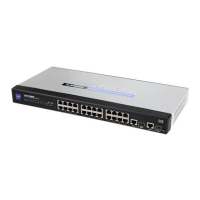Chapter 5
Advanced Configuration
29
24-Port 10/100 + 2-Port 10/100/1000 Gigabit Advanced Smart Switch with 2 Combo SFPs
Spanning Tree > MSTP Interface Settings
Network Administrator can assign MSTP Interface settings
using the MSTP Interface Settings screen.
Spanning Tree > MSTP Interface Settings
Instance Instance to configure. Select the required MST
instance to display the current spanning tree values.
(Range: 0-4094; Default: 0)
Port Displays the port number.
Cost Displays the port’s path cost.
Priority Displays port’s priority value.
Port Fast Indicates if the port has been designated as a
port fast port. If the port has been designated port fast,
the port immediately transitions to the forwarding state.
Force Point-to-Point Link Indicates if this port is a
point-to-point link. If you connect a port to another port
using a point-to-point link and the local port becomes a
designated port, it negotiates a rapid transition with the
other port to ensure a loop-free topology.
Status Displays current state of this port within the
Spanning Tree:
Discarding Port receives STA configuration messages,
but does not forward packets.
Learning Port has transmitted configuration messages
for an interval set by the Forward Delay parameter
without receiving contradictory information. Port
address table is cleared, and the port begins learning
addresses.
Forwarding Port forwards packets, and continues
learning addresses.
Role Indicates the port role assigned by the STP algorithm
in order to provide to STP paths. The possible field values
are:
Root Provides the lowest cost path to forward packets
to root switch.
Designated Indicates that the port via which the
designated switch is attached to the LAN.
•
•
•
•
•
Alternate Provides an alternate path to the root
switch from the root interface.
Backup Provides a backup path to the designated
port path forward the Spanning Tree leaves. Backup
ports occur only when two ports are connected in a
loop by a point-to-point link. Backup ports also occur
when a LAN has two or more connections connected
to a shared segment.
Disabled Indicates the port is not participating in the
Spanning Tree.
Multicast
The Internet Group Management Protocol (IGMP) runs
between hosts and their immediately adjacent multicast
router/switch. IGMP is a multicast host registration
protocol that allows any host to inform its local router that
it wants to receive transmissions addressed to a specific
multicast group.
A router, or multicast-enabled switch, can periodically ask
their hosts if they want to receive multicast traffic. If there
is more than one router/switch on the LAN performing IP
multicasting, one of these devices is elected “querier” and
assumes the role of querying the LAN for group members.
It then propagates the service requests on to any adjacent
multicast switch/router to ensure that it will continue to
receive the multicast service.
Based on the group membership information learned
from IGMP, a router/switch can determine which (if any)
multicast traffic needs to be forwarded to each of its ports.
At Layer 3, multicast routers use this information, along
with a multicast routing protocol such as DVMRP or PIM,
to support IP multicasting across the Internet.
NOTE: IGMP neither alters nor routes IP
multicast packets. A multicast routing protocol
must be used to deliver IP multicast packets
across different subnetworks.
•
•
•

